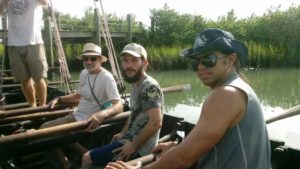
From second left to right: Roger Arrazcaeta Delgado; Marcos Antonio Acosta Mauri; and Yoser Martínez Hernández of the Gabinete de Arqueología of Havana, Cuba at their rowing stations in the chalupa, “San Agustín”.
By Dr. Sam Turner
Between August 25th and September 14th the St. Augustine Lighthouse & Maritime Museum hosted an archaeological cultural exchange which consisted of a visit by three Cuban archaeologists, Roger Arrazcaeta Delgado, Yoser Martínez Hernández, and Marcos Antonio Acosta Mauri, from the Gabinete de Arqueología, or Archaeology Cabinet, based in Havana, Cuba. This cultural exchange was possible through collaborations with the St. Augustine Archaeological Association which sponsored their travel and the Friendship Association which provided financial and logistical support. The purpose of the archaeologists’ visit was to participate in both underwater archaeological fieldwork with the St. Augustine Lighthouse Archaeological Maritime Program (LAMP) and in terrestrial archaeological projects with the City of St. Augustine archaeologist as well as to exchange ideas and methodology from within the international field. Additionally, the guest archaeologists assisted with the analysis of the ceramic material found on the Anniversary Wreck, which is the current focus of LAMP’s field work.
This particular cultural exchange program works to establish and deepen contacts between archaeologists and historians in both St. Augustine and Havana, Cuba in hopes of restoring cultural and scholarly ties between these two cities following a thawing in international relations. This is considered especially important given that these two cities’ histories have been closely intertwined for much of the last 450 years.
The Cuban archaeologists were able to explore the Anniversary Wreck with Museum archaeologists as well as use a new airlift – an underwater excavation tool – which LAMP has been experimenting with this field season. During their visit, they also visited many historically-significant sites in order to get a comprehensive overview of the history of our city. After visiting Fort Matanzas and the Castillo de San Marcos they became particularly interested in the bronze Spanish artillery captured during the Mexican-American War (1846-1848) and the Spanish-American War (1898). Other visits included: the Alligator Farm; the Spanish Military Hospital; St. Photios Greek Orthodox National Shrine; Tolomato Cemetery; and the Father Felix Varela Shrine.
Director of the Gabinete de Arqueología, Roger Arrazcaeta Delgado, was the featured speaker for the St. Augustine Archaeological Association’s monthly speaker series delivered at Flagler College on September 5th. His talk, entitled, The Frigate Navigator and its British Shipment: History and Archaeology, focused on a shipwreck east of the city of Havana which they have recently investigated and identified. The talk was well attended by approximately 75 people.
Our Cuban colleagues were especially pleased to meet and spend time with St. Augustine resident Dr. Kathy Deagan, one of the world’s foremost experts on Spanish colonial archaeology who took them on a guided tour of the first colony exhibit in Government house and discussed her work on numerous Spanish colonial archaeological sites in St. Augustine and abroad. They also had the pleasure and honor of helping crew St. Augustine’s tall ship, the San Agustín, an authentic and faithful replica of a Spanish watercraft known as a chalupa. This watercraft was built as a legacy project of the 450th anniversary of the founding of St. Augustine as a partnership between the St. Augustine Lighthouse & Maritime Museum, The St. Augustine Maritime Heritage Foundation, and the Fountain of Youth Archaeological Park. This replica vessel is used every year to reenact the landing of Pedro Menéndez de Avilés on Founders Day. Our Cuban colleagues were able to take part in the full landing rehearsal and were to have participated in the landing day festivities set to take place on the September 9th but those plans changed when an unwelcome visitor named Irma came to town.
While here, our colleagues pitched in with the rest of the Lighthouse staff to prepare the entire Lighthouse site for the hurricane which was a two-day process that included striking all the tent tops in our Heritage Boatworks area and boarding up windows. They weathered the storm at Lighthouse Field House where field students and visiting scholars are housed during their stay in St. Augustine. Following the storm, they helped reopen the site for business. Towards the end of their visit, we conducted a study and examination of the ceramic assemblage that was excavated from the Anniversary Wreck and currently under archaeological investigation by LAMP. This included a visit to the city archaeology lab where they met with outgoing city archaeologist, Carl Halbirt, as well as his recently-arrived-replacement, Andrea White. Carl shared a great deal of information including some of his most interesting finds here in St. Augustine, especially the recent excavations of the Spanish cemetery associated with the church of Nuestra Señora de Los Remedios on Charlotte Street.
Unfortunately, as another result of the storm, no archaeological work with the City Archaeologist was possible during this visit. Hopefully next time! We were honored to have international colleagues come to share with us. Our thanks to them and to all who helped host!

